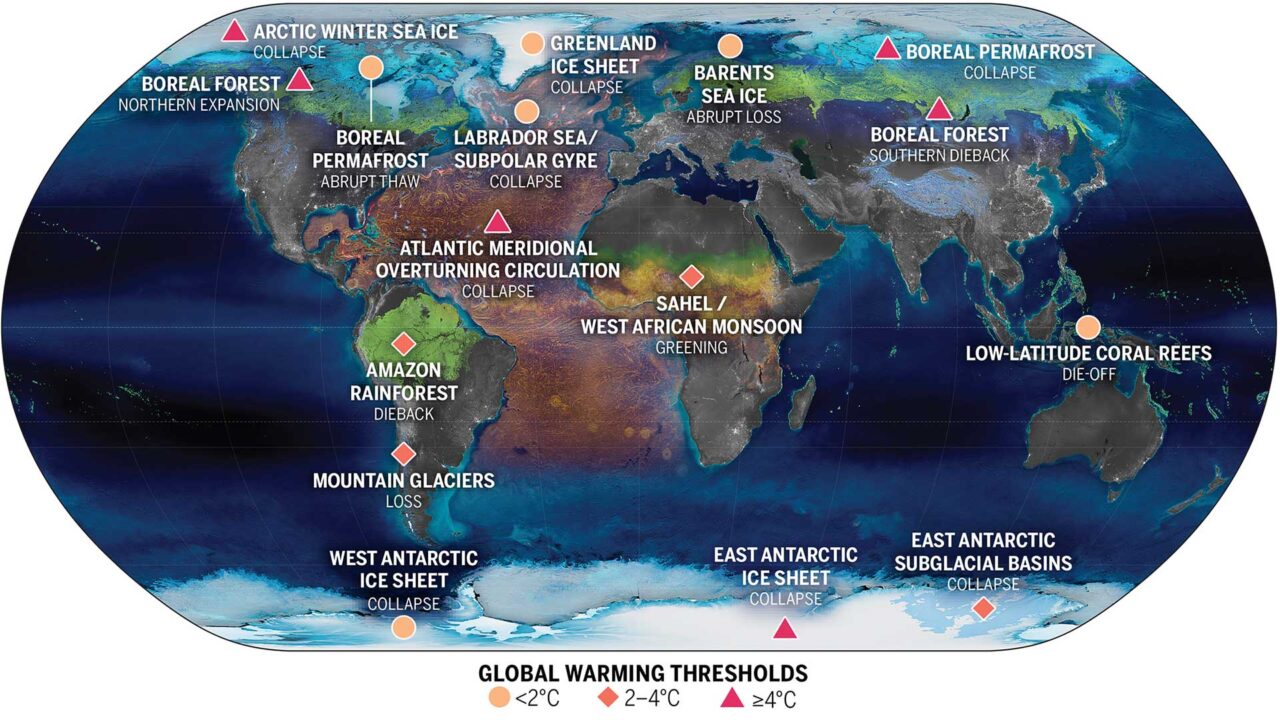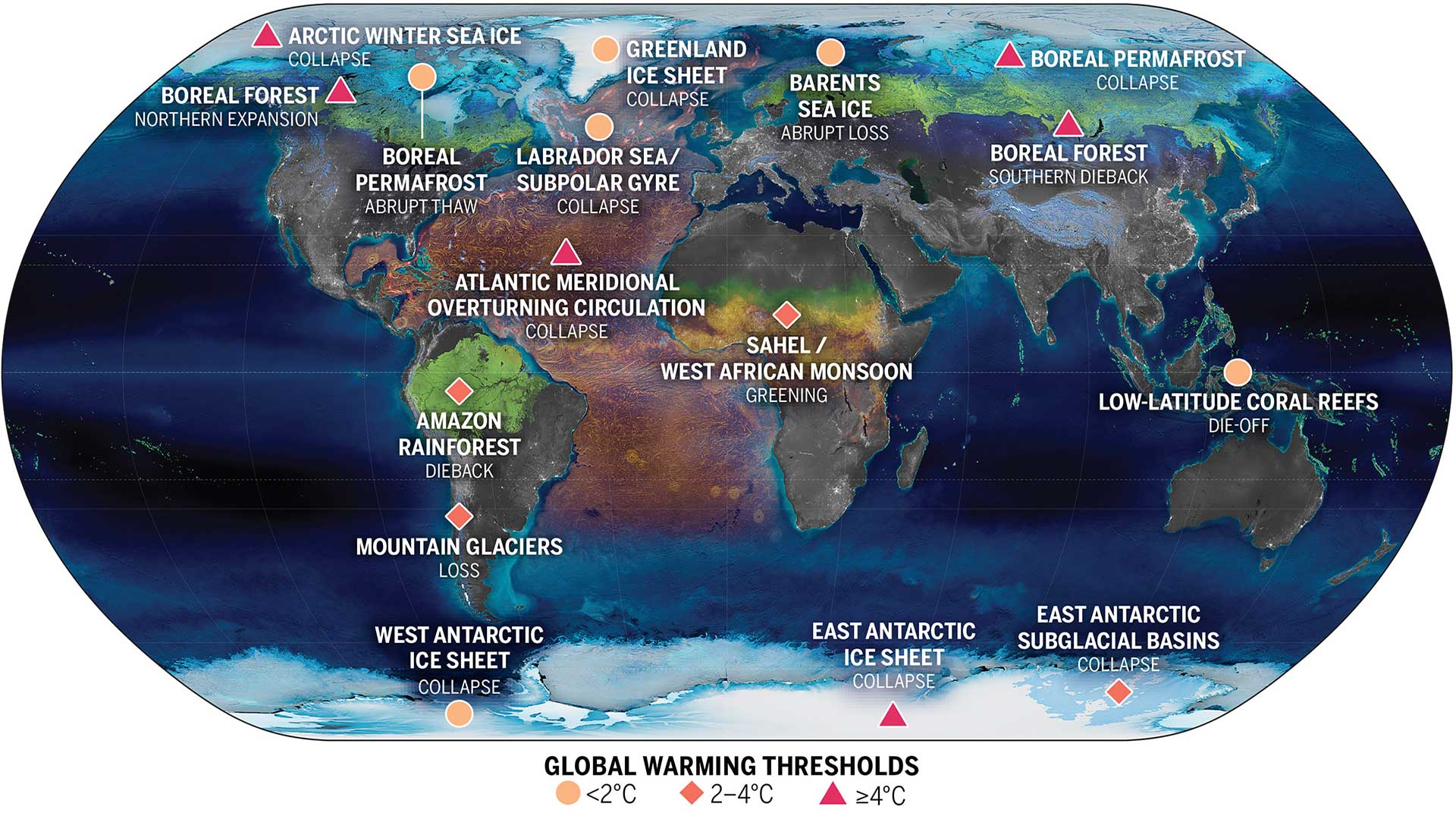We are close to triggering irreversible ecosystem and weather changes
Our environment involves many different systems, and some of them are close to changing in drastic ways, for human time scales irreversible.
Exceeding 1.5°C global warming could trigger multiple climate tipping points
Science (Study): Climate tipping points are conditions beyond which changes in a part of the climate system become self-perpetuating. These changes may lead to abrupt, irreversible, and dangerous impacts with serious implications for humanity. Armstrong McKay et al. present an updated assessment of the most important climate tipping elements and their potential tipping points, including their temperature thresholds, time scales, and impacts. Their analysis indicates that even global warming of 1°C, a threshold that we already have passed, puts us at risk by triggering some tipping points. This finding provides a compelling reason to limit additional warming as much as possible.

Pins are colored according to our central global warming threshold estimate being below 2°C, i.e., within the Paris Agreement range (light orange, circles); between 2 and 4°C, i.e., accessible with current policies (orange, diamonds); and 4°C and above (red, triangles).
The study synthesizes the most current evidence on how much warming would risk passing 16 tipping points, part of the following systems:
- Polar ice
- Permafrost
- Monsoon
- Forest and coral reefs
University of Exeter: The research, published ahead of a major conference “Tipping Points: from climate crisis to positive transformation” at the University of Exeter (12-14 September), concludes we are already in the danger zone for five climate tipping points: melting of the Greenland and West Antarctic ice sheets, widespread abrupt permafrost thaw, collapse of convection in the Labrador Sea, and massive die-off of tropical coral reefs.
Four of these move from “possible” to “likely” at 1.5°C global warming, with five more becoming possible around this level of heating.
The Climate State may Tip at 1.5 or 2 C of Global Temperature Rise (2021)
Science: Many of these systems are already stressed by rising temperatures, and the study finds the world might already be within the warming range where the risk is elevated. It also concludes that even under the most ambitious scenario for limiting global warming—to 1.5°C compared with preindustrial levels—the planet could still see dramatic changes.
It’s a “timely and thorough piece of work,” says Chris Jones, a climate scientist at the Met Office Hadley Centre. The findings are broadly consistent with previous work, he says, but updated and more detailed. He and other climate scientists warn against “cataclysmic” interpretations of the findings. The study also indicates that “a lot of really bad tipping points are still avoidable,” says Zeke Hausfather, leader of climate research at the technology firm Stripe.
Science: To estimate tipping points, University of Exeter earth systems scientist David Armstrong McKay and his colleagues gathered evidence from ancient climate records as well as modern observations, model predictions, and current best estimates. They looked at ecological, atmospheric, and other systems to identify those most at risk of abrupt, irreversible, or self-sustaining change as Earth warms. Then, they estimated the minimum amount of warming that might trigger a tipping point in each system, as well as the maximum warming a system might be able to withstand before a catastrophic shift becomes unavoidable. The authors also made a best estimate of where each tipping point sits—somewhere between the extremes—and noted how high their confidence was in each of the 16 forecasts.
Overall, they found that at the current level of global warming—1.1°C since the preindustrial era—Earth has already passed the low-end risk estimate for five tipping points, putting coral reefs, permafrost, and polar ice at risk. Just 0.8°C of warming may have already accelerated the decline of the Greenland Ice Sheet, and as little as 1°C of warming might have put the West Antarctic Ice Sheet on a path toward collapse. “Once [the ice sheet] starts to collapse and loses ice, it actually pushes itself into an even less stable configuration,” driving sea level rise around the globe, says climate scientist Nerilie Abram of Australian National University. For both ice sheets, however, the authors estimate that 1.5°C is the more likely tipping threshold, and that the sheets might be able to withstand as much as 3°C of warming without irreversible decline.
Holding global warming to 1.5°C to 2°C—the rough goal of the Paris agreement—could mean exceeding the best estimates for seven tipping points, the study found, causing the loss of mountain glaciers and the disruption of key ocean currents. Although the 1.5°C Paris target was initially a “number of convenience” produced by diplomatic maneuvering, Armstrong McKay says the study reinforces the perils of not meeting that goal.
Other researchers agree. The paper synthesizes a “huge amount of evidence,” Abram says, and makes it easier for policymakers and others to see how societal choices could help avoid—or hasten—tipping points.
But too great a focus on specific temperature thresholds could feed arguments that nothing can be done to keep warming to safer levels, warns Bob Kopp, a climate scientist at Rutgers University, Piscataway. “I don’t believe in magic numbers in the climate system,” he says. “I worry about [tipping points] feeding this idea that there is this threshold, and below it we’re OK, above it we’re not.” Instead, he says, each increment of warming produces additional risk.
The authors hope their work will instigate more concerted research on tipping points. They note, for example, that they have “low confidence” in many of their thresholds.
Related
Risk of passing multiple climate tipping points escalates above 1.5°C global warming (2022)
